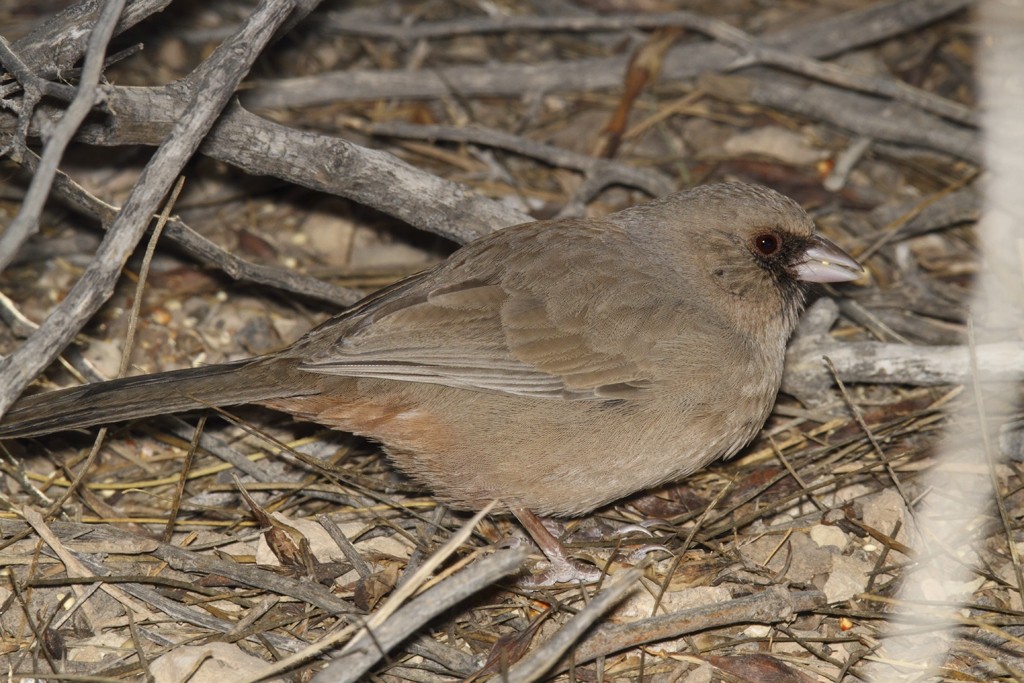Abert's Towhee
A species of Ground Sparrows and Brown Towhees Scientific name : Melozone aberti Genus : Ground Sparrows and Brown Towhees
Abert's Towhee, A species of Ground Sparrows and Brown Towhees
Botanical name: Melozone aberti
Genus: Ground Sparrows and Brown Towhees
Content
Description General Info
Description
Abert's towhees are recognized by their relatively long tails, dark faces, and overall brown plumage. They are related to sparrows and juncos but are more similar to thrashers in appearance. They may be confused with the California towhee, but their dark faces are more distinct, and the range of these species only slightly overlaps. The Abert's towhee is the longest species in the diverse Emberizidae at 21 to 25 cm (8.3 to 9.8 in) long, but its length is boasted by a relatively long tail, at 10 to 12 cm (3.9 to 4.7 in) in length. Males weigh from 40–54.1 g (1.41–1.91 oz), with an average of 47.1 g (1.66 oz), while females weigh from 39.5–51 g (1.39–1.80 oz), with an average of 44.8 g (1.58 oz). In terms of weight, it is outweighed by several other towhee species. Among standard measurements, the wing chord is 8.2 to 9.7 cm (3.2 to 3.8 in), the bill is 1.5 to 1.6 cm (0.59 to 0.63 in) and the tarsus is 2.6 to 2.9 cm (1.0 to 1.1 in). 
Size
24 cm (9.5 in)
Colors
Brown
Black
Gray
Life Expectancy
8 years
Nest Placement
Tree
Clutch Size
1 - 4 eggs
Incubation Period
2 broods
Nestling Period
12 - 13 days
Feeding Habits
Abert's Towhee's diet includes insects such as beetles, ants, grasshoppers, cicadas, and caterpillars, more heavily in summer (95%) and less in winter (70%). They forage by rummaging in leaf litter or soil, sometimes probing like a nuthatch. Their plant diet mainly consists of grass, saltbush, and amaranth seeds. They scratch at the ground for seeds and occasionally eat grubs.
Habitat
Abert's Towhee inhabits the arid Lower Sonoran desert's brushy riparian zones, flourishing in dense underbrush of native shrubs. Its preferred terrain includes cottonwood-willow forests and mesquite bosques near water sources. Adaptable to human-altered environments, abert's Towhee also occupies suburban areas with similar vegetation, utilizing invaded tamarisk stands and agricultural areas for expansion.
Nest Behavior
During nesting, abert's Towhee exhibits a pattern of building their nests in dense parasitic mistletoe or foliage-rich areas, ensuring concealment and shade. Both parents partake in caring for eggs and young, reflecting evolved parental behavior.
Nest Characteristics
Abert's Towhee's nests are found 5–7 feet high in dense vegetation like boxthorn and Baccharis or trees such as mesquite and cottonwood. The bulky cup-shaped nest is constructed from mesquite leaves, bark, and other plant materials, measuring approximately 4 inches tall and 5.4 inches wide.
Dite type
Insectivorous
General Info
Feeding Habits
Bird food type
Bird Feeder Type

Platform
Sounds
Call
Recording location: United States
Call
Recording location: United States
Call
Recording location: United States
Behavior
Abert's Towhee are primarily ground foragers, engaging in a distinctive 'double-scratch' technique to discover insects and seeds beneath leaf litter. They are most active in their search for food during the cooler morning and late afternoon hours, often retreating to the shelter of thickets to rest during the intense midday heat. Dust baths are a frequent part of abert's Towhee's routine for parasite control. Despite their somewhat inconspicuous presence in arid habitats, they exhibit boldness, often defensively interacting with conspecifics and various other bird species over territory and resources. These birds establish permanent territories, with males performing vocal displays and aerial pursuits to deter rivals, while females are more ground-oriented in their defense tactics. To reinforce monogamous bonds, pairs engage in a unique 'squeal duet.' While their territorial behavior diminishes out of breeding season, lifelong partners may still perform duets occasionally.
Species Status
Not globally threatened.
